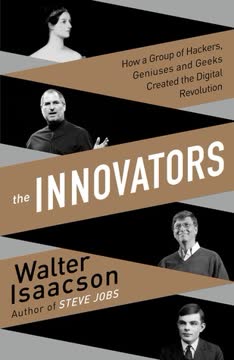Key Takeaways
1. Culture is the foundation of innovation and success
"Culture stems from founders, but it is best reflected in the trusted team the founders form to launch their venture."
Authentic values matter. A company's culture should be based on genuine beliefs and practices, not just hollow slogans. Smart creatives are drawn to organizations with strong, authentic cultures that align with their own values.
Key cultural elements:
- Crowded, messy offices that encourage interaction
- Functional integration of teams
- Meritocracy of ideas, not hierarchy
- Freedom to take risks and innovate
- Transparency and open communication
Culture is the bedrock upon which successful companies are built. It attracts top talent, shapes decision-making, and ultimately determines whether an organization can innovate and thrive in a rapidly changing world.
2. Attract and empower smart creatives to drive growth
"Smart creatives are the key to achieving success in the Internet Century."
Who are smart creatives? They combine deep technical expertise with business savvy and creative flair. Smart creatives are passionate, curious risk-takers who thrive on solving big problems and aren't afraid to challenge the status quo.
How to empower smart creatives:
- Give them freedom and autonomy
- Provide access to information and resources
- Create opportunities for impact beyond their job description
- Encourage them to pursue "20% time" projects
- Reward them based on merit and impact, not tenure
Building a team of smart creatives and creating an environment where they can flourish is essential for companies looking to innovate and grow in the Internet Century.
3. Embrace "think big" mentality and set ambitious goals
"If you're thinking big enough it is very hard to fail completely."
10X thinking. Instead of incremental improvements, aim for transformative innovations that are ten times better than existing solutions. This mindset attracts top talent and inspires teams to tackle seemingly impossible challenges.
OKRs (Objectives and Key Results):
- Set ambitious, measurable goals
- Make them public and transparent
- Encourage high failure rates (70% completion is good)
- Use them to align the entire organization
By setting audacious goals and encouraging employees to think beyond conventional limits, companies can achieve breakthroughs that redefine industries and create massive value.
4. Foster a decision-making process based on data and merit
"The CEO needs to be the CIO."
Data-driven decisions. In the Internet Century, companies have access to unprecedented amounts of data. Leaders should leverage this information to make informed decisions rather than relying on intuition or hierarchy.
Key principles:
- Default to open sharing of information
- Encourage healthy debate and dissent
- Make decisions quickly, but be willing to change course based on new data
- Empower those closest to the data to make decisions
- Use metrics to measure progress and success
By creating a culture that values data-driven decision-making and meritocracy of ideas, companies can make better choices and adapt more quickly to changing circumstances.
5. Prioritize hiring as the most critical function of leadership
"Hiring is the most important thing you do."
Hiring process:
- Involve peers in the hiring decision, not just managers
- Look for learning animals and generalists, not just specialists
- Use challenging, open-ended interview questions
- Set a high bar and be willing to leave positions unfilled
- Make hiring decisions by committee to avoid bias
Retention strategies:
- Provide opportunities for growth and impact
- Offer competitive compensation, especially for top performers
- Create a culture that smart creatives want to be part of
Investing time and resources in hiring the best people is crucial for long-term success. Leaders should view hiring as their most important job and create systems to attract, evaluate, and retain top talent.
6. Create an environment that encourages risk-taking and learning from failure
"To innovate, you must learn to fail well."
Embrace failure as a learning opportunity. In a fast-moving, innovative environment, failure is inevitable. The key is to fail fast, learn from mistakes, and apply those lessons to future efforts.
Strategies for encouraging risk-taking:
- Celebrate bold attempts, not just successes
- Create a "safe to fail" culture where employees aren't punished for taking risks
- Encourage rapid prototyping and iteration
- Allocate resources (like Google's 20% time) for experimental projects
- Share stories of failures and lessons learned
By fostering an environment where employees feel safe to take risks and learn from failure, companies can accelerate innovation and stay ahead of the competition.
7. Focus relentlessly on the user to drive product excellence
"Product excellence is the only way for a company to be consistently successful."
User-centric approach:
- Prioritize user experience over short-term revenue
- Make decisions based on what's best for users, not just the business
- Continuously gather and analyze user feedback
- Invest in long-term product improvements, even if they don't have immediate payoff
Examples:
- Google's commitment to fast, relevant search results
- Removing ads that don't enhance user experience
- Launching free products (like Google Maps) to build user base before monetization
By consistently prioritizing user needs and experience, companies can build products that people love and use regularly, creating a strong foundation for long-term success.
8. Communicate openly and transparently to build trust
"Default to open."
Transparency builds trust. Open communication fosters a culture of trust, empowers employees, and leads to better decision-making across the organization.
Communication strategies:
- Share information broadly, including board meeting notes and company financials
- Use regular all-hands meetings to discuss company strategy and answer questions
- Encourage leaders to be accessible and respond quickly to employee concerns
- Create systems (like Google's "Dory") for anonymous question submission
- Use multiple channels (email, in-person, video) to reach all employees
By prioritizing open and transparent communication, companies can build stronger relationships with employees, foster innovation, and create a more engaged workforce.
9. Innovate through technical insights and rapid iteration
"Ship and iterate."
Technical insights drive innovation. Look for fundamental technical breakthroughs that can solve problems in new ways or create entirely new markets.
Rapid iteration process:
- Identify a technical insight
- Build a minimum viable product
- Launch quickly with limited fanfare
- Gather user feedback and data
- Iterate rapidly based on learnings
- Scale successful products, kill failures quickly
By combining deep technical expertise with a willingness to launch imperfect products and iterate quickly, companies can innovate faster and more effectively than competitors.
10. Adapt to the platform-driven economy of the Internet Century
"In the Internet Century, a product excellence is now paramount to business success—not control of information, not a stranglehold on distribution, not overwhelming marketing power."
Platform thinking:
- Build ecosystems, not just products
- Create value for multiple stakeholders (users, developers, partners)
- Leverage network effects to drive growth
- Open up APIs and encourage third-party innovation
Examples:
- Android's open-source mobile operating system
- Google's advertising platforms (AdWords, AdSense)
- Amazon's marketplace for third-party sellers
Companies that successfully build and leverage platforms can create massive value and disrupt traditional industries. Leaders must understand this shift and adapt their strategies accordingly to thrive in the Internet Century.
Last updated:
FAQ
What's How Google Works about?
- Insight into Culture: The book delves into Google's unique culture and management practices, highlighting the importance of hiring smart creatives and fostering innovation.
- Foundational Principles: It outlines key principles guiding Google's decision-making, such as focusing on user experience and leveraging technical insights.
- Real-World Examples: The authors share anecdotes and lessons from their experiences at Google, illustrating how these principles are applied in practice.
Why should I read How Google Works?
- Learn from Leaders: Gain insights from Eric Schmidt and Jonathan Rosenberg, who played pivotal roles in Google's success.
- Applicable Strategies: The principles discussed are valuable for anyone interested in management and innovation across various industries.
- Inspiration for Entrepreneurs: The book encourages thinking big and taking risks, motivating aspiring entrepreneurs.
What are the key takeaways of How Google Works?
- Hire Smart Creatives: Emphasizes hiring individuals who are intelligent, passionate, and innovative for success.
- Culture of Openness: Encourages transparency, collaboration, and experimentation to foster innovation.
- Focus on Technical Insights: Stresses the importance of basing products on strong technical insights for innovative solutions.
What are the best quotes from How Google Works and what do they mean?
- “Manage the environment”: Highlights creating a supportive environment for smart creatives to thrive without micromanagement.
- “Talk to the engineers”: Reflects Google's belief in empowering employees and valuing their input over traditional management.
- “Your people make you a leader”: Emphasizes that true leadership comes from inspiring and empowering others.
What is the concept of "smart creatives" in How Google Works?
- Definition: Smart creatives are individuals with technical expertise, business acumen, and creativity.
- Importance: Attracting and retaining smart creatives is essential for innovation and success in the fast-paced Internet Century.
- Characteristics: They are curious, risk-taking, and collaborative, thriving in environments that encourage experimentation.
How does How Google Works define the hiring process?
- Peer-Based Hiring: Advocates for a committee-based hiring process to ensure candidates are selected based on merit.
- Focus on Quality: Stresses that urgency should not compromise the quality of hires; finding the right fit is crucial.
- Data-Driven Decisions: Hiring decisions should be supported by data and objective assessments for effectiveness.
How does Google make decisions according to How Google Works?
- Consensus-Driven Approach: Involves all stakeholders in discussions for an inclusive decision-making environment.
- Role of Decision-Maker: Emphasizes having a single decision-maker to set deadlines and cut off unproductive debates.
- Use of Data: Decisions are informed by data analysis, with caution against over-analysis for timely decisions.
What is the 70/20/10 rule mentioned in How Google Works?
- Resource Allocation Strategy: Allocates 70% of resources to core activities, 20% to emerging products, and 10% to high-risk projects.
- Encouraging Innovation: Fosters an environment where innovative ideas can be explored without fear of failure.
- Balancing Focus: Ensures core business support while allowing room for growth and experimentation.
What is the significance of 20 percent time in How Google Works?
- Freedom to Innovate: Allows employees to spend work hours on personal projects, fostering creativity and innovation.
- Successful Projects: Many successful Google products originated from 20 percent projects, demonstrating its value.
- Cultural Impact: Encourages a culture of experimentation and ownership, empowering employees to pursue their ideas.
How does How Google Works address failure in innovation?
- Failing Well: Advocates for a culture that accepts failure as part of the innovation process.
- Learning from Mistakes: Emphasizes analyzing failures to extract insights for future projects and decisions.
- Encouraging Risk-Taking: Creates an environment where failure is not stigmatized, encouraging bold ideas.
What role does culture play in How Google Works?
- Foundation of Success: A strong company culture is essential for attracting and retaining top talent.
- Alignment with Values: Google's culture aligns with its core values, guiding employee behavior and decision-making.
- Difficult to Change: Once established, culture is hard to change, making it crucial to define and cultivate from the outset.
How does How Google Works suggest companies should approach innovation?
- Continuous Product Excellence: Success comes from continuously delivering high-quality products.
- Embrace Failure as Learning: Encourages viewing failures as opportunities for learning and growth.
- Leverage Technical Insights: Innovations should be based on strong technical insights for groundbreaking products.
Review Summary
How Google Works received mixed reviews. Many praised its insights into Google's culture, hiring practices, and management philosophy. Readers appreciated learning about Google's focus on hiring "smart creatives" and fostering innovation. However, some critics felt the book was self-congratulatory and lacked practical advice for non-tech companies. Several reviewers noted that the book's content was repetitive and could have been condensed. Overall, readers found the book interesting but not groundbreaking, with useful nuggets of information interspersed throughout.
Similar Books










Download PDF
Download EPUB
.epub digital book format is ideal for reading ebooks on phones, tablets, and e-readers.






